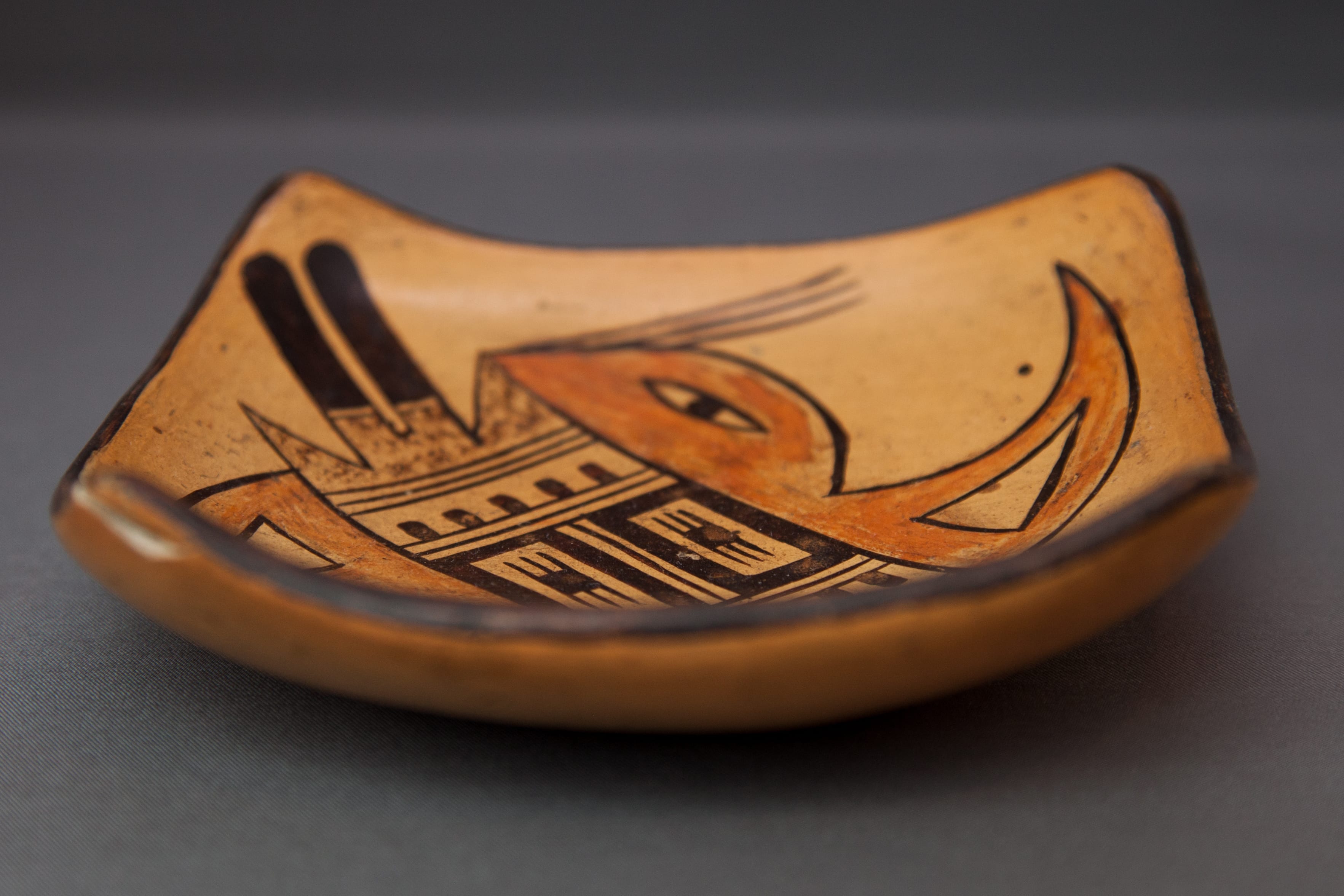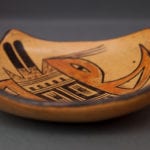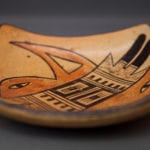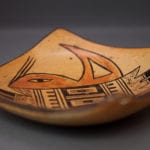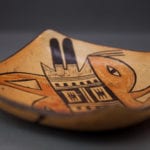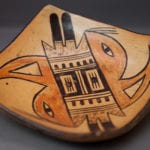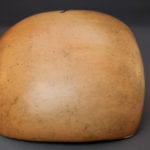While this is an unusual shape for a Hopi pot, it is also simply formed by cutting out a flat square of clay and raising the four corners. The pot fired evenly, without much blushing.
The interior design is folk art, not fine art. What would ya call these creatures? Perky what? Two mice a hunting for cheese? A cross between a VW Beetle and a mouse? I cannot help but smile.
The rim is painted black, and on one side, paint has dribbled down the outside.
Other than that dribble, the painting is exceptionally well done: confident, detailed, and clear. The central black motif contains familiar Sikyatki elements: two “butterfly” (or shrine) elements are at the center. These are often found at the center of Nampeyo’s “Bird Hanging from Sky Band” bowls. (See 1993-04.) Flanking this center is a series of short lines (five on one side, six on the other) the only asymmetry on the pot. Such asymmetric detail is also typical of Nampeyo’s work. (See 2002-03.) This central black design is caped at both ends by pairs of linear “eagle tails” flanked by triangular elements another common design element used by Nampeyo. (See 2013-03, among others.)
Flanking the central black motif are t mouse-lie creatures, one right-side up and one up-side down and facing in opposite directions. Painted red, they have black framing lines, eyes, and whiskers. These are cute creatures, with perky tails and whiskers and eyes directly observing the viewer. Each tail incorporates an unpainted isosceles triangle, which interrupts the broad expanse of red paint (as do the eyes).
The design turns out to be highly sophisticated with multiple energizing strategies:
1) As noted above, the two sets of short black lines in the center have an unequal number of lines, thus throwing the design slightly off balance;
2) The design is painted on a diagonal to the shape of the pot. Thus the design seems large for the area of the dish and the thrust of the design seems to push against the square “cage” of the pot’s shape;
3) The two mouse-like creatures move in opposite directions, thus also drawing the viewer’s eye in opposite directions;
4) When one mouse is right-side up the other is up-side down, adding interest;
5) The direction of the two mouse tails add a counter-clockwise thrust to the overall design, thus opposing the diagonal force of the central black motif; and
6) The use of unpainted surfaces highlights and contradicts the painted surfaces. For example, the thin curved red tails thrust up in a counterclockwise direction from the center of the design. The neighboring unpainted surface between the whiskers and the tail forms a wider curved element the pulls the eye down in a clockwise direction.
7) The black elements in the red areas of the design create visual linkage to the black core.
8) Much of the energy of the design derives from the contrast between linear and curvilinear elements. This strategy is employed several times on this small pot:
a) Most obviously, the bold linearity of the black central element (particularly the two black tails on either end) is in tension with the curvilinear tails and heads of the mouse-like creatures.
b) The linearity of the tail triangle and the linear whiskers frame the curvilinearity of both the red tail and the unpainted surface between.
c) This gets a little complicated: If you ignore the red area of the tails and just focus on the unpainted tail triangle and the unpainted surface between whiskers and tail, one sees that these unpainted surfaces contradict each other both in direction and in linear/curvilinear form
In short, for a small seemingly simple dish, the design on 2013-26 contains strategies that are both surprisingly complex and yet subtle. The interweaving of these strategies into an overall pattern is extraordinary and far more sophisticated than typical or even very good Hopi-Tewa pottery.
Indeed, of the six characteristics that define Nampeyo’s mature style (Appendix C), little dish 2013-26 clearly incorporates four and perhaps a fifth:
1) A tension between linear and curvilinear elements often represented as a contrast between heavy and delicate elements;
2) A deliberate asymmetry of design;
3) The use of color to integrate design elements;
4) Nampeyo’s painting is confident, bold, and somewhat impulsive compared to the more-studied, plotted and careful style of her daughters, descendents and other Hopi and Hopi-Tewa potters.
Nampeyo also is noted for:
5) The use of empty (negative) space to frame the painted image.
As detailed above, the painter of 2013-26 does use unpainted areas of dish 2013-26 to highlight the design. However, perhaps because of the small surface area and the complexity of the motif, the use of unpainted surfaces is different than on larger Nampeyo pots. See, for example, see bowls 2002-03 or 2012-21 or seedpot 2005-16 where a substantial percentage of the surface area is left unpainted so as to highlight and frame the decoration. There’s not a high percentage of unpainted surface on dish 2013-26, but the maker does show a skill at using unpainted surfaces to interrupt and frame the design elements. This kind of sensitivity to space is characteristic of “The Old Lady.”
Only the use of a thick above a thin framing line on the interior rim is completely missing from dish 2013-26, perhaps because it is small and not round.
When I purchased dish 2013-26 off the internet, I was attracted to the skill of its painting and its folk art creatures. The dish makes me smile—an important criterion of my connoisseurship. I did not expect that I was buying a Nampeyo pot. As I began examining the pot in-hand, I was surprised by the sophistication of its design strategy and that analysis revealed a pattern of design strategy very much like the one I had previously defined as characteristic of the mature Nampeyo.
So, what kind of attribution am I willing to affix on this little dish? As with bowl 2013-17, I am not ready to attribute it to Nampeyo unless I can link it to a known Nampeyo pot of similar design.
Should future research locate a pot with good Nampeyo provenance and similar creatures and design, I would consider identifying her as the maker.

